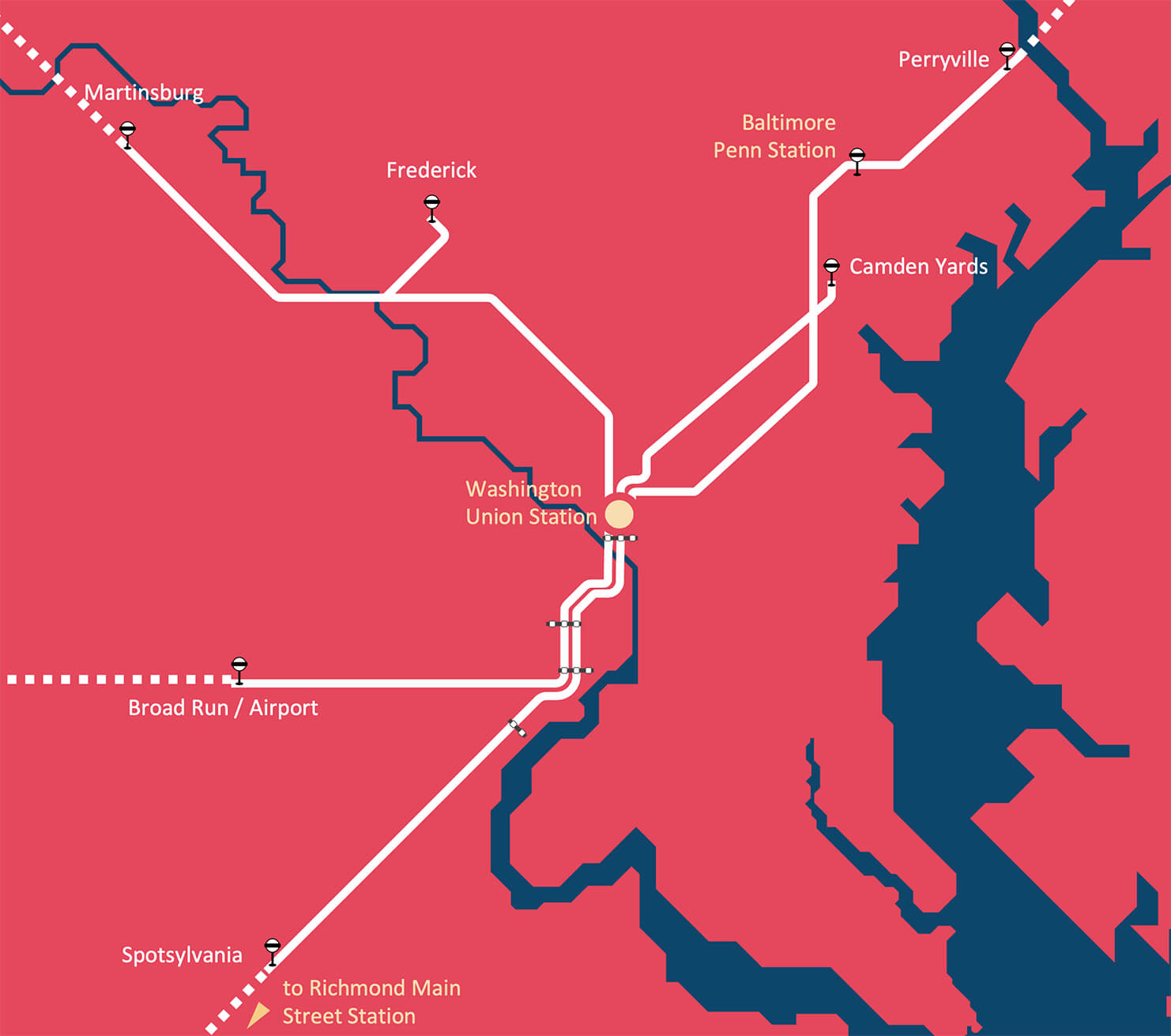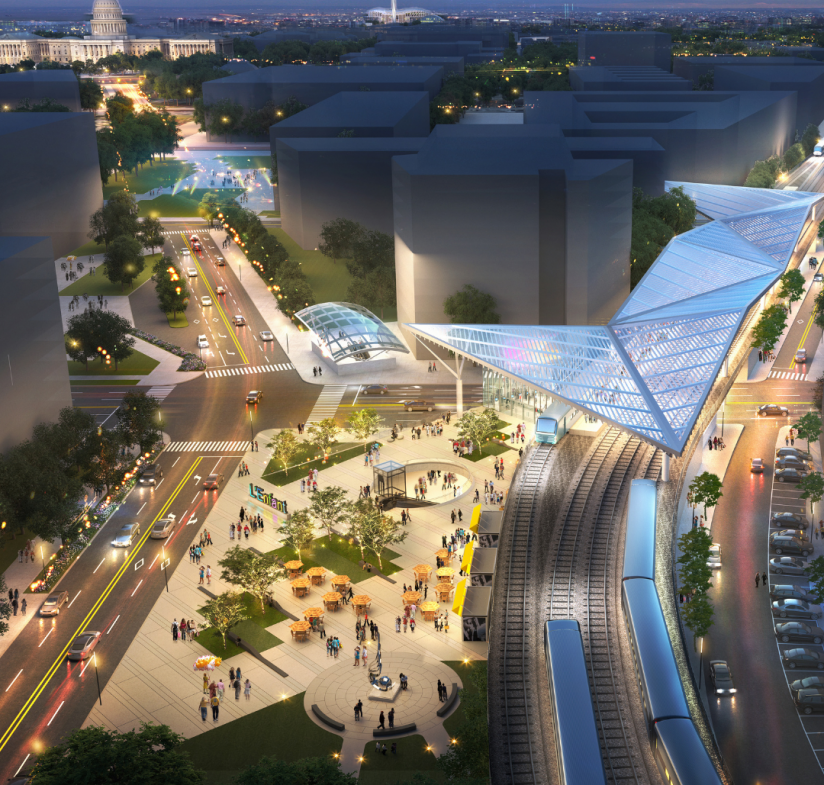The Capital Region of Baltimore, Washington, and Richmond has an immense opportunity to spur regional economic competitiveness and collaboration, build the nation’s most inclusive economy, and increase access to affordable housing for millions of residents by focusing on a key transportation asset — the extensive regional rail network.
The regional rail network can increase access to jobs, education, and the region’s rich cultural assets in the region’s core, emerging activity centers, suburban areas, and our outdoors. However, while our rail network is superior to many domestic regions, the opportunity is out of reach because many of our rail assets are far beyond their useful life, and the operations are not organized to meet the travel demand for the region’s families and employers. This leaves many areas of the region underserved, with nearly all residents losing access to service outside of peak commuting periods.
The Capital Region Rail Vision seizes on recent wins for the region’s rail network and charts a course for a transformed rail system that offers seamless, all day connections that span the Potomac River and rail operators to connect Maryland, the District, and Virginia and deliver a globally competitive system that takes the Capital Region to new heights.

The region’s rail operations are outdated, with the existing fragmented network designed to get workers in and out of the District of Columbia during peak weekday commuting periods.
This operation makes rail travel more complicated, less useful, and more time-consuming, and in turn, limits the region’s economic productivity and comes at a cost to residents, neighborhoods, and employers. The Vision’s transformed network leverages the planned investments to remove key infrastructure bottlenecks like Long Bridge, Washington Union Station, and the B&P Tunnel, and adds incremental and steady operational improvements over four planning phases – Launch, Expand, Realize, and Transform – that provide steppingstones to a full delivery within the next 25 years.
The regional rail network represents an untapped resource. Once the Vision is implemented, the region can expect an increase in our economic productivity of $1.3 billion annually from the expanded service, $40 billion from the capital program, and hundreds of thousands of quality jobs created. As the Rail Vision is implemented, the region must adopt policies to expand inclusive growth around our regional rail stations and preserve access to opportunities for the 700,000 Black residents, 400,000 Hispanic residents, and 95,000 households below the poverty line that live within two miles of regional rail stations today.
This is an ambitious, quarter-century Vision for the Capital Region. Delivering it will enhance our region’s economic competitiveness, expand access to more affordable housing and walkable communities, and provide for a more inclusive and connected region for all families. Success will require key stakeholders to build durable relationships that span jurisdictional borders and political cycles like we have not seen before. Fortunately, in recent years the region has shown the unity needed to deliver transformative outcomes that this Vision can build from. We know that the Capital Region has the talent, commitment, and capacity, when we work together, to transform our region’s rail network and in so doing transform our region’s social and economic mobility. This Vision helps set our course, and, together, we will deliver.
Goals of the Regional Rail Vision
Enhance Regional Economic Competitiveness and Collaboration:
Mobility and access are key enablers for regional growth. Better access to current and future employment centers for workers – and access to an expanded pool of regional talent for businesses of all sizes – will enhance the region’s productivity and create the foundation for a growing, competitive region.
Ensure Inclusive Growth:
Transportation investments throughout the United States have historically divided, displaced, or created barriers to access and opportunity for communities of color and low-income areas. As a nation and a region, we have yet to remove these barriers for too many communities which have reinforced systemic and generational inequities that have limited upward mobility and held back our region’s full potential. The Vision, and all transportation plans and investments in this region, should prioritize expanding access to economic opportunity for communities of color as well as historically marginalized communities.
Expand Access to Moderate and Affordable Housing:
The Capital Region is facing housing affordability challenges that undermine many residents’ quality of life and access to economic opportunity, which also impacts employers’ decisions on where to locate. The transportation network, including regional rail, has a large role to play in housing decisions by expanding the utility, reliability, and access to more housing, jobs, and other key destinations. Regional rail has a large unmet opportunity to increase access to moderately and affordably priced housing and support the creation of new transit-oriented housing and commercial development opportunities through the region. Limited run-through service today between Maryland and Virginia limits residents’ ability to access new jobs or affordable housing options across borders.
Rail Vision Key Elements
-
Bidirectional run-through service:
One-seat rides in both directions between Maryland, the District, and Virginia.
- Bidirectional, run-through service on all MARC & VRE lines serving all Core Stations*
-
Increased level of service:
Enhanced service from Martinsburg West Virginia, Perryville and Baltimore Maryland through the District to Broad Run and Spotsylvania, Virginia
- All-day service on all MARC & VRE lines**
- 15-min or more frequent peak period weekday service, including greatly expanded express/limited stop service
- 1-hour or less midday service
- 1-hour or less weekend service for all core stations
-
Improved operational coordination::
One operationally integrated network for Maryland, the District, and Virginia
- Seamless Capital Region rail operation
-
User-facing integration::
Integrated system brand and fare policy to create an easy-to-use regional network
- A unified fare policy, with policies aimed at serving all trip types
- A single Capital Region rail brand, for all MARC & VRE services
*The Vision considers Core Stations to include all stations from Frederick to Union Station on MARC Brunswick Line, Baltimore to Union Station on MARC Camden and Penn Lines, and Alexandria to Union Station on VRE Fredericksburg and Manassas Lines.
** All day service could extend from 4 AM through 12 AM during the week. All day, but more limited, hours and service could be offered on the weekends, potentially mirroring the MARC Penn line existing span of roughly 7 AM to 10 PM on Saturdays and 9 AM to 6 PM on Sundays.

